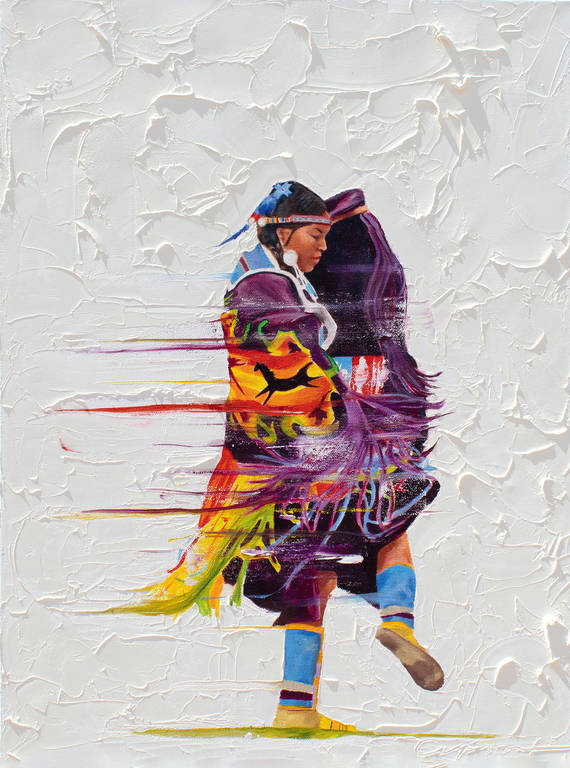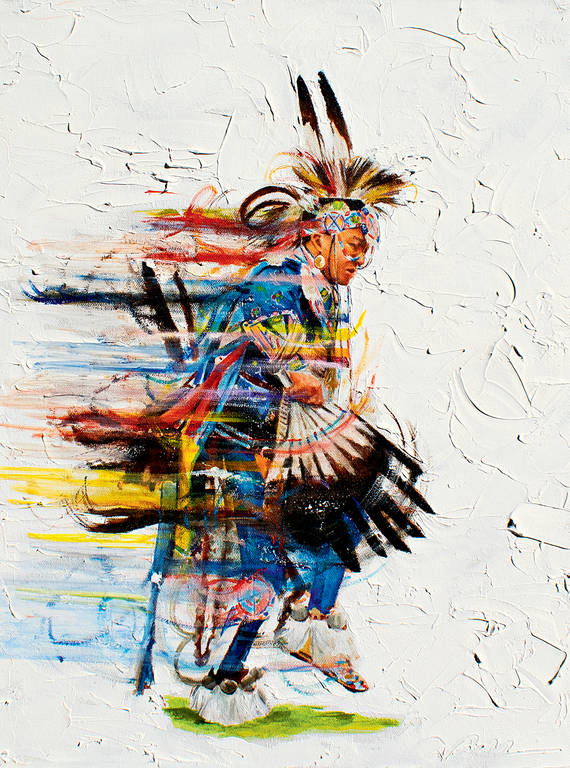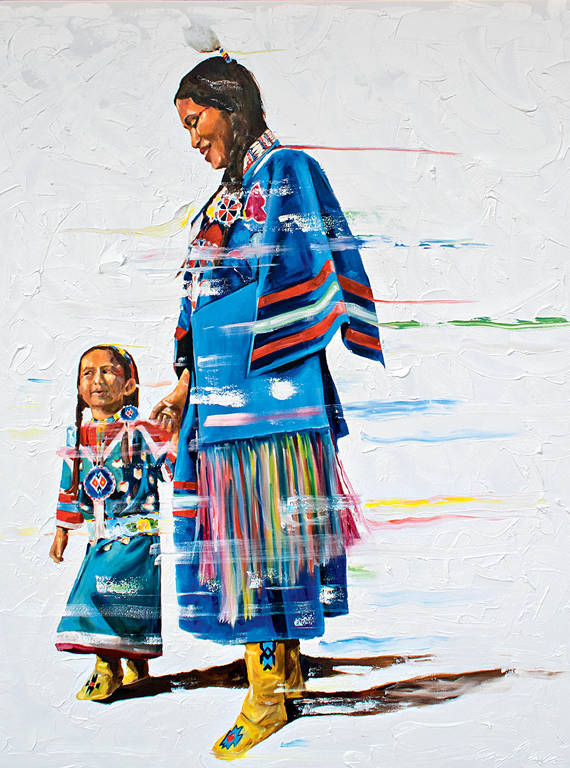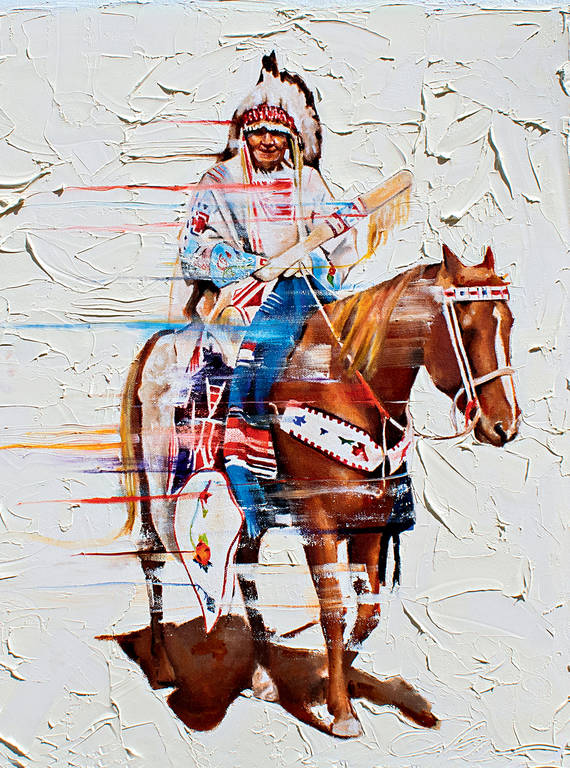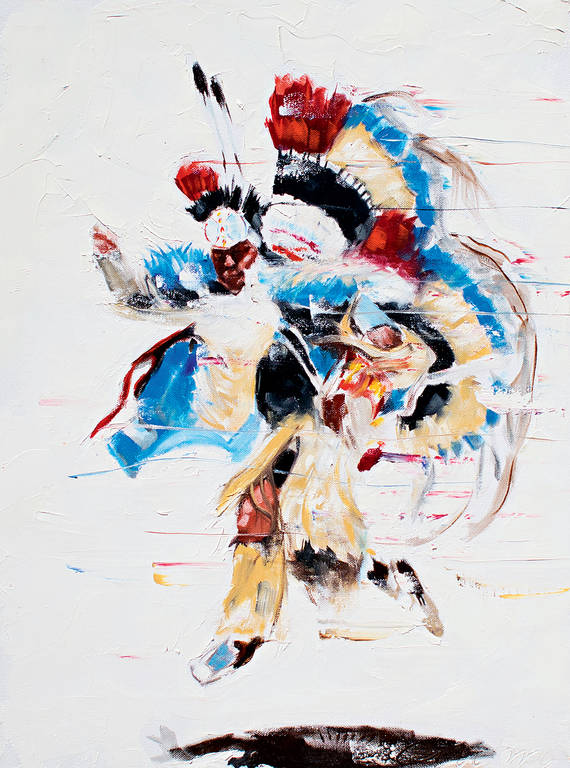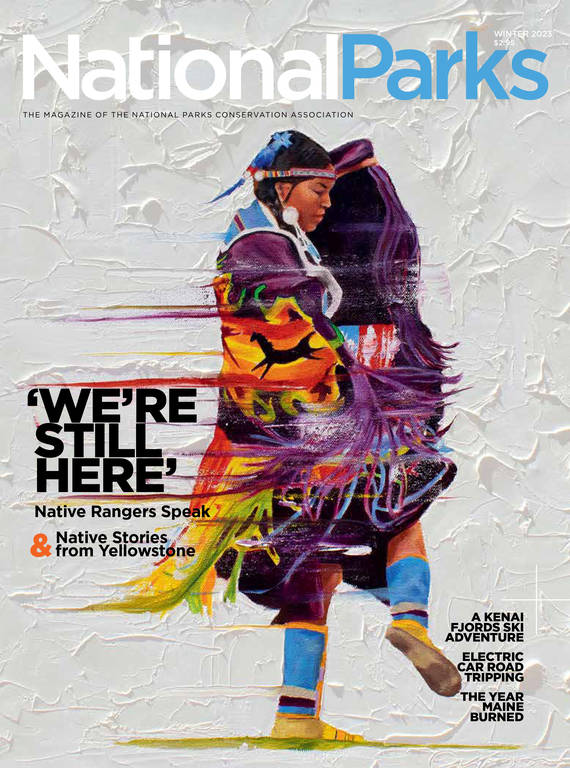Winter 2023
Land of Steam
An Apsáalooke writer shares three stories that shed light on his people’s connections to the lands of Yellowstone National Park.
Stories are an integral part of the human condition, and they are the most powerful tools we have to shape our understanding of the universe and guide our paths forward. Both old stories and new have the power to inform us, entertain us and bring us together as kindred folk. Whether told through living breath or signs on paper, the oldest stories inspire us to consider the human roots of our modern world: Where do we come from, what makes us special, and how can we honor our ancestors, ourselves and future generations? Ancient stories about a homeland are a deep kind of knowledge that allows us to know the place — not just with our heads, but with our hearts — and that is true whether or not you are Indigenous to a place.
Yellowstone National Park is an ancient Native homeland, and at least 27 Tribal Nations maintain strong connections to sacred sites within the park. My Tribe, the Apsáalooke (Crow), know it as Awé Púawishe, the Land of Steam, and our intimate knowledge of this land goes back centuries.

Commemorating Yellowstone’s 150th Birthday with the Park’s ‘First Family’
The world’s first national park marks a significant milestone today — but its history reaches much further back than 1872 and involves the stories and cultures of more than…
See more ›Growing up on the Crow Indian Reservation in the 1970s and ’80s, I wasn’t aware of the significance of the park to my Tribe or my family. Colonial calamities such as forced relocation, smallpox epidemics, warfare, Indian boarding schools and modern education systems devoid of Native American content or perspective all worked against my Tribe’s oral tradition of passing knowledge down to the next generation. Many of my peers and I simply didn’t learn about the age-old, rich cultural connection to the Land of Steam held by our ancestors. When I first visited Old Faithful as an 8-year-old tourist from Crow Agency, Montana, I was oblivious to the importance of the place to my great-great-grandparents. As I aged and matured, I sought to learn as much as I could about my culture – turning to Tribal elders, oral historians and rare written materials such as ethnographies. Learning about my Tribe’s history in Yellowstone and the stories associated with it, I realized that this sacred homeland was the source of many foundational aspects of my culture and my ancestors’ understanding of the world.
Our long history and deep knowledge of the Land of Steam are reflected in the many Apsáalooke place names located throughout Yellowstone that tell of a complex and profound relationship between the people and the landscape. Here are three ancient Apsáalooke origin stories about some of Yellowstone’s most prominent landmarks.
“Beauty in Purple,” oil on canvas, 2020
©DEL CURFMAN“Rhythm of the Song,” oil on canvas, 2021
©DEL CURFMAN“Mother’s Knowledge,” oil on canvas, 2020
©DEL CURFMANWHERE ELK RIVER BEGINS/IICHÍILIKAASHAASHE ALACHILICHE (YELLOWSTONE LAKE)
Yellowstone Lake has several Apsáalooke names, including Where the Elk Flirt and Elk Lake, that relate to the herds of elk that return in the spring and the summer, following an ancient migration pattern. It’s no surprise that Yellowstone’s largest lake, a body of water surrounded by geologic and hydrothermal wonders, represented a source of primordial power to the Apsáalooke community, and the stories about the place reflect that importance. These oral traditions help explain unique behavioral aspects of the region’s wildlife, seasonal weather phenomena, and even human nature and our relationship to the animal kingdom. One noteworthy story about the lake touches on all these themes and provides insight into the Apsáalooke cosmological belief system.
Apsáalooke philosophy divides the universe into three realms. First is the Above World, where the stars, birds and clouds reside. The second is the Surface of the Earth, where many powerful beings exist and are generally identified as plants, animals and minerals. The third is Under Water/Earth, where beings such as fish, otters and turtles reign supreme. Otters are regarded by the Apsáalooke as the most dominant of all water beings. Within this tri-layered universe, there is a natural flow and tension between and among all living things.
One very old story, as shared by Apsáalooke elder Harry Bull Shows, is as follows: In the time of bows and arrows lived a great hunter. He was so skilled that he always brought home meat, and because he wore an antelope hide on his back as a disguise, he became known as Packs Antelope. Above Yellowstone Lake, a pair of Thunderbirds, eaglelike figures, lived on top of a high butte that no one could climb. Every spring, the eaglets fledged and shook off their downy feathers, which the wind would carry down to the lake, where they would collect on the water like driftwood. A powerful and crafty long-bodied otter creature lived in the depths of the lake. When he would see the feathers, he would use his powers to cause a heavy fog that cloaked the butte. Under the fog’s cover, he would climb the steep mountain and devour the young Thunderbirds.
A LONG-STANDING PRESENCE
The devastated Thunderbird parents had seen Packs Antelope hunt and knew he was very skillful with his bow, so they decided to ask him to kill the long otter beast. One day, when Packs Antelope grew drowsy after a hunt, he lay down to rest. The male Thunderbird took him away in his talons and carried him to the butte. When Packs Antelope awoke, he was surprised to find out where he was. He looked over the edge, and the wind blew upward into his face. It was impossible to descend. Then he heard two eaglets crying, “Save us, save us, save us, brother.” He asked why they cried, and they explained: Every spring, their parents had two hatchlings, and when they fledged, a fog would develop, and the long otter would come out of the lake and eat them. These eaglets were just starting to lose their downy feathers.
Suddenly, a fierce storm blew in, thunder boomed, and lightning struck the butte. It was the father Thunderbird. He told Packs Antelope, “Don’t be afraid. I’m the one who brought you here. I want you to use your skills to kill the beast that eats my children.” Packs Antelope said he would do his best.
That night, Packs Antelope could feel the fog setting in, and the next morning the air was completely clouded. Packs Antelope took his bow and all his arrows in his left hand and climbed to a sheltered spot below the nest. Soon, he could hear and smell the long otter coming. When Packs Antelope could see the long otter’s head, he sent an arrow into its neck. It opened its mouth in pain, and Packs Antelope shot another arrow into its throat. He could hear it falling and rocks tumbling. The sun rose higher, and the fog lifted. Packs Antelope could see that the long otter was dead at the base of the butte.
The male Thunderbird called all the birds to feast on the dead animal. Hawks and eagles of all varieties came to eat. Then Packs Antelope said, “Those are my sacred arrows. I want them back in one piece, without a scratch.” The Thunderbird called the cliff swallows, since they build their nests in little places. A whole bunch of swallows went into the mouth of the long otter. They could be heard inside the beast, chirping and flittering around. Soon the swallows returned with the two arrows undamaged.
Then the Thunderbird said, “I am going to make a special shield to show my appreciation for your help. When you meet an enemy, never attack first. Use this shield to protect yourself, then you shoot him with your arrows. This way you will always win.” On the shield, the male Thunderbird painted two Thunderbirds, a male and a female. He then grabbed Packs Antelope in his claws, flew over the great lake and returned him to his people.
THE BULL/CHÍILAPE (DRAGON’S MOUTH) AND MOUNTAIN LION/ IISHPÍIA (MUD VOLCANO)
Apsáalooke and other Indigenous people of the Northern Plains are expert sky watchers, and much of their ceremonial way of life is embodied in their respect for the sun, moon, planets and stars. In Yellowstone, ancient stories shared by the Apsáalooke, Blackfeet and others explain the creation of important geologic features on and within the ground. The story of the Dragon’s Mouth and the Mud Volcano are powerful examples of this circle of knowledge.
There are several known versions of this story, and all vary slightly, but the general narrative remains the same. In the beginning, the Sun tricked a Native woman into marrying him and starting a family in the sky. Their son became the Morning Star. But the woman was lonesome and longed to return to the ground, where her family and loved ones were left behind. When she finally escaped and used a rope to lower herself and her son to the ground, the Sun became enraged and threw a rock down on her, killing her and leaving their son an orphan on the Earth. He was raised by an old grandmother figure who taught him to be a good person and use his special powers to help people. As he grew, he did many good deeds, including rescuing the people from an evil and giant bison bull who was sucking them into his stomach. Before returning to the sky to be with his father and other relatives, he transformed the giant bison into the hot spring now known as the Dragon’s Mouth and placed a mountain lion nearby, in the boiling mud pot that today is called Mud Volcano, to keep watch over the bull in case it ever returns to life. This explains the growling and rumbling sounds that emanate from these mysterious holes in the earth.
“Grandfather’s Knowledge,” oil on canvas, 2019
©DEL CURFMAN“Supaman,” oil on canvas, 2018
©DEL CURFMANRED WOMAN’S DIGGING STICK/HÍSSHISHTAWIA ISBACHÍPE (LIBERTY CAP)
The hot springs at Mammoth are also graced by a significant cultural landmark: Red Woman’s Digging Stick. Standing prominently in front of the Mammoth Terraces, this 37-foot-high and 10-foot-wide limestone formation is known today as the Liberty Cap. It was named so by geologist Ferdinand Hayden in 1871 because it reminded him of the rounded peasant hats worn during the French Revolution and depicted on early American coins. This noteworthy travertine structure is a cultural nexus point — its transcendent story connects every Tribe of the region. The oral tradition that illuminates the origin of the Digging Stick also explains the creation of a star pattern that includes the constellation better known as Orion. The part of the story of Red Woman that relates to the Divine Twins is known by the Apsáalooke from the east, Blackfeet from the north, Shoshone from the south and Salish from the west. Although their languages are mutually unintelligible and their histories in the region are all separate and distinct, all these Tribes share a version of this epic tale.
ABOUT THE ARTIST
The story begins with a married couple living on their own and preparing to start a family. They were happy and doing well, until one day when the husband left his pregnant wife alone to go hunting. While he was gone, an evil and stealthy monster, Red Woman, visited the wife and took advantage of her kindness and generosity, killing her and attempting to do the same to her unborn babies. Red Woman disposed of the twins by throwing one in a nearby spring and the other behind the lining of the poor couple’s teepee. The babies survived against all odds, and their names became Thrown Behind the Liner and Thrown Into the Spring. According to the story, Thrown Into the Spring became a creature of the water before his father transformed him back into a human when he was a toddler by taking him into a sweat lodge and making it so hot that he remembered who he really was. Having recovered from their near-death experiences, the twins now had super strength and resiliency, and they sought to be a force of good in the world by ridding the land of all monsters, including the one that took their mother from them — Red Woman. Eschewing their father’s warning to avoid her, they chose to track her down and make her accountable for her sins. When they finally found her, she ran from them into the night sky, but they caught her and used their knives to exact revenge — cutting off her hand and leaving it in the heavens, while her digging stick fell to earth. The constellation Orion is the palm of her hand, with her fingers stretching out and beyond, and her stick became the travertine feature of Mammoth Hot Springs.
The Divine Twins story unites people across the mountains, plateaus, prairies and valleys, and it extends well beyond the borders of today’s national park, illustrating the centrality of Yellowstone as a homeland for many Tribes. Yellowstone has been bringing diverse people together since time immemorial, which may be this extraordinary place’s greatest legacy: providing our chaotic material world with an ancient connection to nature that we all can understand from the heart.
About the author
-
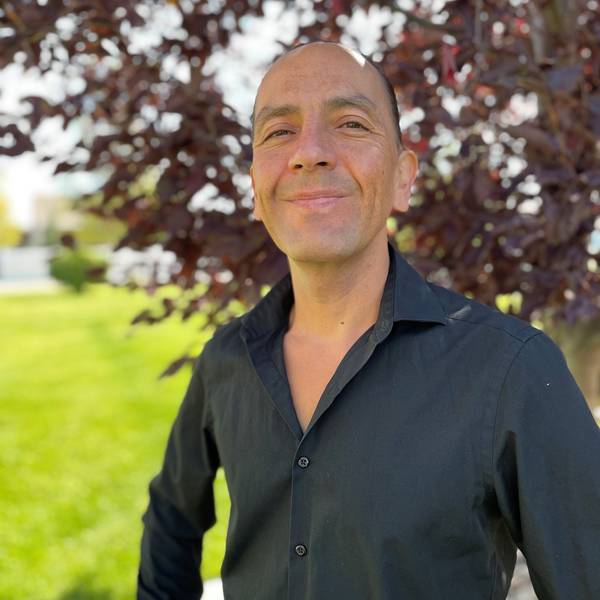 Dr. Shane Doyle, Apsáalooke Contributor
Dr. Shane Doyle, Apsáalooke ContributorDr. Shane Doyle, Apsáalooke, is an educational and cultural consultant who hails from Crow Agency, Montana. His work includes archaeological and genetic research, curriculum design, performance art production, and environmental advocacy. Doyle helped commemorate Yellowstone Park's 150th birthday by coordinating the installation of the All Nations Teepee Village at Madison Junction in August 2022. Dr. Doyle lives in Bozeman with his wife Megkian and their five children.
